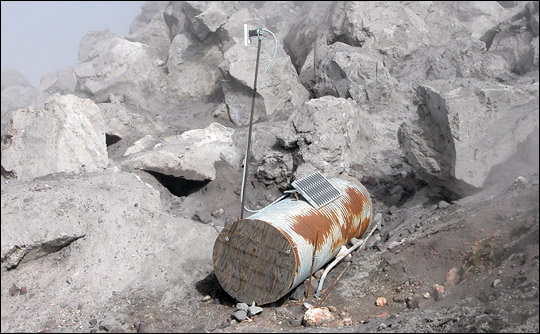

Improving the Sensor Web | |||
The Volcano Sensor Web proved its value in disaster planning, but the process still required some human involvement. After the satellite transmitted the images and thermal data, Davies had to produce maps to send to his colleagues. “It was all done in about 30 minutes,” he recalls, but in the future, even map production and delivery will be automated. Davies is also working with scientists at the Hawaiian Volcano Observatory and Mt. Erebus Volcano Observatory to build more model data into the sensor web system, allowing it to be triggered not just by ongoing eruptions but also by precursors to eruptions. “When magma moves up from depth in a volcano, the volcano bulges,” he explains. Ground-based tilt meters that measure changes in slope steepness could detect these bulges and trigger a satellite observation. |
|||
 | |||
Besides planning future refinements to Earth-based autonomous systems, Davies looks beyond our home planet to envision how they might work elsewhere. “Mars is a good example,” he says. “We’re looking at a time in the future when there are multiple assets [orbiters, rovers], and they can communicate with each other. A smart system can help maximize the resource usage and data return. There’s also the safety aspect. Something in orbit could detect a storm moving in, and it could warn assets on the ground to hunker down for the duration.” Picturing sensor webs on other planets comes naturally to Davies, who took a circuitous route to watching Nyamuragira. Long before he monitored Earth’s volcanoes, he studied volcanoes a little more remote—over 600 million kilometers away, on Jupiter’s moon Io. Scientists didn’t even know Io’s volcanoes existed before 1979, when NASA’s Voyager 1 spacecraft provided a revolutionary view of the moon. |
Tilt meters, like this one installed on Mount St. Helens, can signal impending eruptions by detecting changes in slope caused by magma moving beneath a volcano. The next step for the Sensor Web is to allow it to be triggered not just by signs of active eruption, such as lava or ash, but also by signs of impending eruption, such as slope changes. (Photograph courtesy USGS Cascades Volcano Observatory.) | ||

“One of the great discoveries of planetary science was the detection of these huge, hot volcanoes,” Davies remarks. “Up to that point, it was thought that all the moons of the outer planets were just these little, cold, dead ice balls.” Figuring out how to study this distant moon drew Davies to the Autonomous Sciencecraft Experiment, which uses Earth as an analog for remotely observing other worlds. “When they came to me and asked, ‘What would you like to look at [with the sensor web]?’ I said ‘Volcanoes, of course!’” His fascination with Io continues, helped by his Earth-based observations. He has just published a book comparing volcanic activity on the two worlds. Yet despite his fundamental interest in distant moons, Davies takes considerable pleasure in his success here on Earth. “The folks on the ground were delighted with the Nyamuragira data,” he says. He estimates that the Volcano Sensor Web had autonomously tasked itself to take observations hundreds of times before. “But this was the first time where the system demonstrated a vastly superior response to the normal way of doing business. There have been proof-of-concept successes in the past but nothing quite like this.”
|
Scientists hope to extend automated sensor webs throughout the solar system. These far-flung observatories will be able to catch dynamic events such as Io’s erupting volcanoes. This sequence of images from the New Horizons mission shows the 330-kilometer- (200-mile-) tall plume of Io’s Tvashtar volcano. (NASA animation courtesy Johns Hopkins University Applied Physics Laboratory/Southwest Research Institute.) | ||